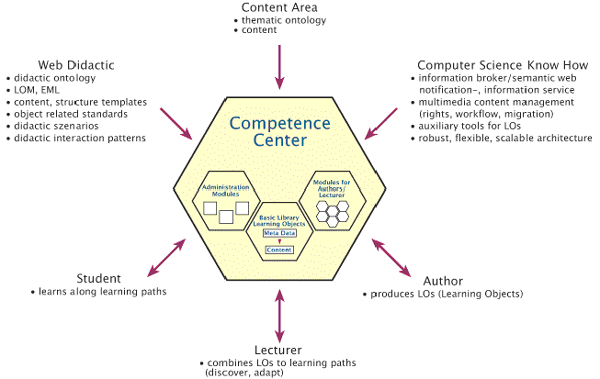Given current technology, the development of substantial eLearning materials that exhibit high quality content and are useful in different educational settings is extremely time consuming and costly. This process typically involves different competencies including domain knowledge, didactic capacity, media design skills, usability and accessibility know-how, and programming abilities. The high development costs are only justified if learning contents remain valid for a long period of time or if the development effort for materials that need to be updated frequently can be shared by many users and is applicable in different educational settings. To achieve this goal, different projects pursued research on a modular approach towards multimedia content that ultimately led to novel learning technology standards, such as LOM (Learning Object Metadata) or SCORM (Sharable Content Object Reference Model), and a number of reusable learning object repositories. Experience has shown, however, that LOM and SCORM are weak in handling pedagogical qualities and content repositories are not as successful as expected. This may be due to the fact that these repositories merely focus on content qualities and content management and that they largely neglect the pedagogical context in which such content objects are used and searched for. Another reason is probably the fact that a widely accepted educational categorization scheme for educational scenarios for eLearning applications does not exist as yet.
The CampusContent project, which starts March 1, 2005, takes up these challenges in an interdisciplinary research approach aiming at the development of a competence center for the production, collection, quality assurance, distribution and re-use of modular multimedia content. The project will adopt the open content approach and rely on open standards. Although – for capacity reasons - the project primarily focuses on the subject areas computer science, engineering and natural sciences, its methods and tools will be designed in such a way that they can be carried over to other disciplines as well. Combining the perspective of advanced computer science methods with models and concepts of media didactics and educational science, the project tries to integrate a technological, pedagogical and social dimension seamlessly.
The technology dimension addresses:
-
the design of a suitable, fine-granular learning object model including rich pedagogical attributes, ontology information standardizing domain knowledge and other meta data supporting, e.g., the discovery of learning objects, their (dynamic) recombination, and their integration with pedagogical scenarios;
-
a framework architecture supporting the combination of learning objects, pedagogical scenarios and e-learning tools into a coherent learning environment; and
-
the implementation of an open content portal providing access to a component, template and pattern repository (cf. Figure 1)

Figure 1 - Organization of the CampusContent Portal
We hope to leverage the productivity of multimedia content production substantially through the provision of more effective methods and tools than we have at our hands today. In particular, we plan to develop reusable design patterns and templates that allow us to cope with great deal of standard problems. We are, for instance, envisaging an innovative animation component system that would allow even IT-illiterate authors to transform their conceptual and didactic ideas into instructive animations and other forms of (audio-) visual representations. Authors would no longer be plagued with low-level programming tasks using Java, Flash, Director and other specialist tools and the sustainability of works could be managed much easier.
The pedagogical dimension aims at a categorization of typical pedagogical scenarios and interaction patterns and a novel web didactic in which such scenarios and interaction patterns are related to a rich repository of learning objects of varying degrees of difficulty, didactic model and media presentation. Through a pedagogy-based extension of current metadata standards we hope to be able to combine learning objects in different pedagogical scenarios meaningfully. If we succeed in organizing learning objects addressing the same learning objective in different ways into clusters of variants, a dynamic linkage of learning objects depending on individual learner profiles becomes possible in a learning process.
The social dimension of the projects strives to build up a community providing for
-
external collaboration,
-
continuous dissemination of the communities’s approach and intermediate results,
-
sustainability and quality of the results, and
-
progress of related national and international standards.
CampusContent is one of currently four Competence Centers for Research Information that were set up in 2004 by the Deutsche Forschungsgemeinschaft (DFG, German Research Foundation). These competence centers are financially supported by the DFG over a period of five years.
Prof. Dr.-Ing. B.J. Krämer
bernd.kraemer@fernuni-hagen.de
Prof. Dr.-Ing. F. Kaderali
firoz.kaderali@fernuni-hagen.de
Prof. Dr. P. Baumgartner
peter.baumgartner@fernuni-hagen.de